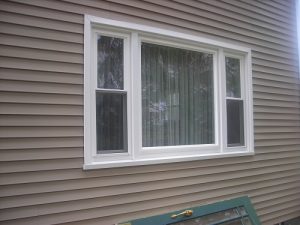What Makes Windows Energy Efficient?
 If you’ve gone to a home improvement trade show recently, you’ve likely seen this display: a cross-section of one window brand next to the cross-section of an unnamed competitor’s window. The inside of window A is complex, with many inner chambers and intricate components, while the inside of window B is fairly simple, just a frame and a pane of glass. The point is to show how much more advanced and thus energy efficient the first window is compared to the second, but do you really understand what you’re looking at? What, exactly, makes windows energy efficient? It’s a combination of several things. Let’s review the basics.
If you’ve gone to a home improvement trade show recently, you’ve likely seen this display: a cross-section of one window brand next to the cross-section of an unnamed competitor’s window. The inside of window A is complex, with many inner chambers and intricate components, while the inside of window B is fairly simple, just a frame and a pane of glass. The point is to show how much more advanced and thus energy efficient the first window is compared to the second, but do you really understand what you’re looking at? What, exactly, makes windows energy efficient? It’s a combination of several things. Let’s review the basics.
Frame Material
For a material to be energy efficient, it needs to be a poor conductor of heat. Although wood is a poor thermal conductor, it’s also prone to warping, rotting, and insect damage. Aluminum frames are excellent condors of heat, which make them poor insulators. Vinyl and fiberglass frames are now the standard for energy-efficient windows, with vinyl being the more affordable of the two.
Glass
Glass coatings can help improve energy efficiency, and the most common of those is low-E or low-emissivity films. Made from extremely thin layers of silver or other types of reflective materials, these coatings work by allowing visible light to pass through, while reflecting a significant percentage of both ultraviolet and infrared light. That means outside heat stays outside (great during the hot summer), and inside heat stays inside (ideal during cold winter months).
Warm Edge Spacers
A spacer is the part of the frame that separates one pane of glass from another in multi-pane windows. Warm edge spacers are designed to prevent external temperatures from migrating through the outside of the frame to the inside. They also reduce condensation on the inside surface of the glass.
Gas Fills
To maximize thermal performance, the highest-rated energy-efficient windows have three panes of glass with argon or krypton gas trapped between each layer. These gases are heavier than air and much more thermally stable, meaning it’s hard to raise or lower their temperatures. This makes them great insulators. Although krypton provides better performance than argon, it’s also more expensive.
The Company to Turn to for Energy-Efficient Windows
Seaway Window manufactures and installs our exclusive collection of energy-efficient windows that are available in a variety of styles such as double-hung, casement, and more. Contact us today and schedule a no-obligation consultation to learn more.

